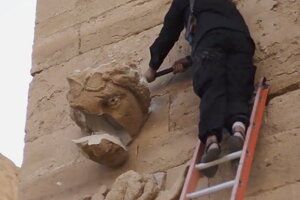Video shows Islamic State smashing ancient Iraqi city. Real or fake?
A new video uploaded late last week shows militants smashing walls with sledgehammers and firing at statues with AK-47s in the ancient Iraqi city of Hatra, in what appears to be the group’s latest efforts in its ongoing purge of Iraq's and Syria’s cultural heritage.

In this image made from a militant video posted on YouTube on Friday, April 3, 2015, which has been verified and is consistent with other AP reporting, a piece falls off from a curved face on the wall of an ancient building as a militant hammers it in Hatra, a large fortified city recognized as a UNESCO World Heritage site, 110 kilometers (68 miles) southwest of Mosul, Iraq.
Militant video/AP Photo
Another ancient city has fallen into the destructive hands of the Islamic State.
A new video, uploaded April 3, appears to show militants smashing walls with sledgehammers and firing at statues with AK-47s in the ancient Iraqi city of Hatra, a UNESCO world heritage site.
The footage reveals the extremist group’s latest efforts in its purge of Iraq's and Syria’s cultural heritage – particularly ancient relics that the group regards as false idols, based on their strict interpretation of Islamic law.
Running just over seven minutes, the video includes aerial scenes of the site and footage of militants taking hammer, pickaxe, and gun to 2,000-year-old statues and carvings, all to the sound of militaristic musical scoring. One jihadist, speaking Arabic with a Gulf accent, said they destroyed the site because it is “worshipped instead of God,” according to The Associated Press.
The video supports a previous AP report, which said that residents living near Hatra, located some 290 kilometers northwest of Baghdad, heard large explosions and saw bulldozers razing the site.
Once a large fortified city under the rule of the Parthian Empire, Hatra was the capital of the first Arab kingdom and withstood Roman invasions in 198 and 116 AD, according to UNESCO. Its destruction represents the latest Islamic State attack against the region’s cultural heritage – attacks that UNESCO Director-General Irina Bokov has denounced as war crimes.
“[N]othing is safe from the cultural cleansing underway in the country: it targets human lives, minorities, and is marked by the systematic destruction of humanity’s ancient heritage," Ms. Bokov said in a statement released in early March.
Bokov's reaction echoes that of archeologists, historians, and others who in the last few months have condemned videos showing Islamic State, or ISIS, crushing ancient artifacts, many of them in Mosul. But reports have surfaced that at least some of the relics the militants destroyed were actually copies: For instance, a number of statues and idols in the Mosul Museum, which ISIS targeted in February, were exact replicas of originals found in Baghdad, Deutsche Welle reported. In some cases, the artifacts were not destroyed but stolen and sold in the black market to help fund ISIS, the German publication continued.
That isn't to say the militants didn't manage to destroy any originals, the report noted. And in sabotaging the record of Iraq’s past, ISIS is causing great damage to human history as a whole, Cornell University's Director of the Institute of Archaeology and Material Studies Sturt Manning wrote.
“The smashed artifacts ... are the material record of humanity,” Professor Manning explained in a CNN op-ed. “They are not just for scholars, they are for everyone. They are the text of the past that helps define our future.”
Unfortunately, the deliberate destruction and desecration in war of cultural property has a long history that goes back at least to Greek and Roman times, but there’s no need to go so far back for examples. The Nuremberg Trials after World War II held several Nazi officers accountable for cultural war crimes, sentencing some to death for “for a panoply of violations that included the destruction of cultural property,” journalist Peter Maass wrote for a handbook on war crimes.
The conflict in Bosnia-Herzegovina in the 1990s also led to the willful ruin of more than a thousand mosques and churches, as well as scores of monasteries, archives, libraries, and museums. In 2001, the Taliban set about destroying thousands of ancient Buddhist statues across Afghanistan.
For ISIS, destroying ancient artifacts is seen as a necessary step in building a culturally homogenous Muslim caliphate in the region. The group’s tally of destruction includes Jonah’s tomb, the Mosul museum and library, and the ancient Assyrian capitals of Nimrud and Khorsabad.
In response, the United Nations has called on international leaders and locals alike to come together to protect remaining cultural sites. UNESCO’s Bokova, among the most outspoken opponents of cultural cleansing, last week launched a social media campaign, #Unite4Heritage, in Baghdad. The movement, Bokova said, aims to mobilize the Iraqi youth to respond to what she described as the Islamic State’s goal of dividing societies and sowing hatred.
“We must respond, by showing that exchange and dialogue between cultures is the driving force for all,” she said during the launch. “We must respond by showing that diversity has always been and remains today a strength for all societies... We must respond by claiming our cultural heritage as the commonwealth of all humanity.”

